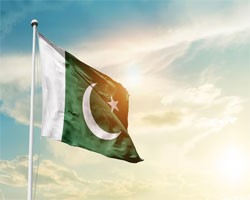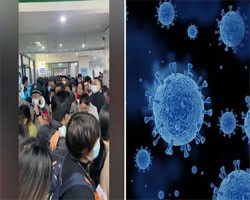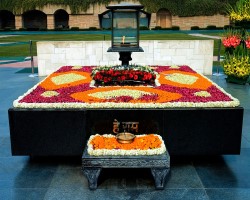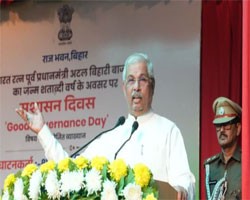Banking Current Affairs
TABLE OF CONTENTS |
| International Relations |
|---|
|
|
|
Key Highlights
Start of Tenure: Pakistan officially began its 2025-26 term as a non-permanent member of the United Nations Security Council (UNSC) on January 1. Eighth Term: This marks the eighth time Pakistan has held a non-permanent seat on the UNSC, previously serving in: 2012-13, 2003-04, 1993-94, 1983-84, 1976-77, 1968-69, and 1952-53. Election Details General Assembly Vote: Pakistan was elected in June 2024 with 182 votes out of 193, significantly exceeding the two-thirds majority (124 votes) required. Replacement: Pakistan replaced Japan, which held the Asian seat for the 2023-24 term. New Members: Along with Pakistan, Denmark, Greece, Panama, and Somalia were also elected as non-permanent members, replacing Japan, Ecuador, Malta, Mozambique, and Switzerland. UNSC Composition Permanent Members (P5): United States, Russia, China, United Kingdom, France (veto-wielding powers). Current Non-Permanent Members: Newly Elected (2025-26 Term): Pakistan, Denmark, Greece, Panama, Somalia. Continuing (2024-25 Term): Algeria, Guyana, South Korea, Sierra Leone, Slovenia. Significance of Pakistan’s Role Geopolitical Context: Tenure begins amidst global geopolitical turbulence, including: Wars in Europe, the Middle East, and Africa. Intensifying rivalries between major powers. A multi-dimensional arms race. Pakistan’s Goals: Halt Wars: Advocate for conflict resolution and the pacific settlement of disputes. Tackle Global Challenges: Address terrorism, arms races, and the emergence of new conflict domains. Promote Peace: Uphold the principles of the UN Charter for maintaining international peace and security. Pakistan’s Population Advantage: As the fifth-largest population, Pakistan aims to play a constructive and active role in international decision-making. Statement by Ambassador Munir Akram Representation: Pakistan’s delegation will have an active and constructive presence on the council. Commitment: Work towards reducing the negative impacts of power rivalries, arms races, and terrorism. Focus Areas: Ensure adherence to the UN Charter and work for international peace. About United Nations Security Council (UNSC) What is the UNSC? It is one of the main bodies of the United Nations (UN), responsible for maintaining international peace and security. All UN Member States must follow its decisions. Key Functions: Identifies threats to peace or acts of aggression. Encourages peaceful resolution of disputes. Can impose sanctions or authorize military action to maintain peace. Powers: Establish peacekeeping missions. Impose international sanctions. Authorize military action through resolutions. Membership: 15 Members in total: 5 Permanent Members (P5): United States, United Kingdom, Russia, China, and France, who have veto power. 10 Non-Permanent Members: Elected for 2 years by the UN General Assembly, ensuring representation from different regions: 5 from Africa/Asia, 1 from Eastern Europe, 2 from Latin America, 2 from Western Europe/Other areas. Headquarters: Located at the United Nations Headquarters in New York City. |
|
|
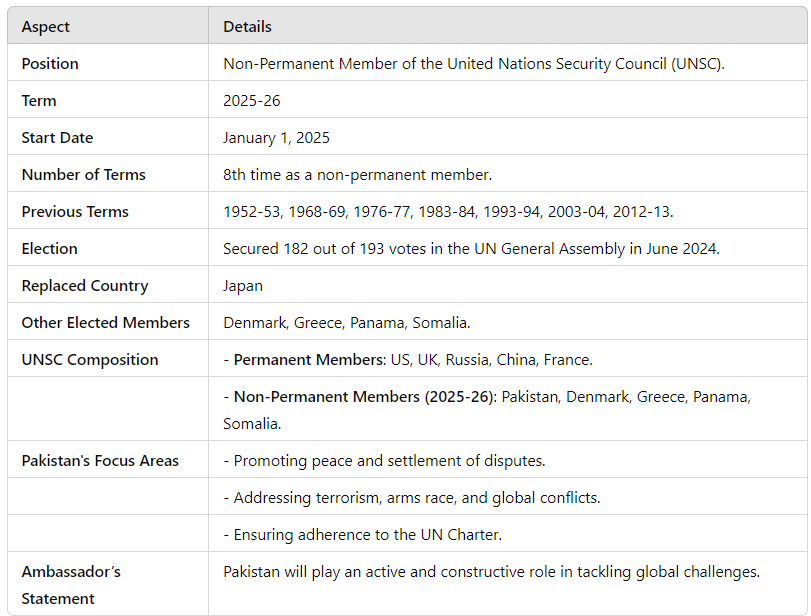
|
|
|
|
Frequently Asked Questions (FAQs) in Competitive Exams:
Q1. Consider the following statements regarding Pakistan's non-permanent membership in the UNSC: 1. Pakistan has been elected as a non-permanent member of the UNSC for the 8th time. 2. Pakistan replaced South Korea in the UNSC for the 2025-26 term. 3. Non-permanent members of the UNSC do not have veto power. Which of the statements given above is/are correct? (a) 1 and 3 only (b) 2 and 3 only (c) 1 and 2 only (d) 1, 2, and 3 Answer: (a) 1 and 3 only Q2. India’s non-permanent membership in the UNSC for 2021-22 focused on which of the following key areas? (a) Counterterrorism and maritime security (b) Global vaccine equity and climate change (c) Both (a) and (b) (d) Reforming the UN Charter Answer: (c) Both (a) and (b) Q3. Which of the following countries were elected alongside Pakistan for non-permanent UNSC membership for the 2025-26 term? (a) Denmark, Greece, Panama, Somalia (b) Algeria, Guyana, South Korea, Sierra Leone (c) Japan, Ecuador, Malta, Mozambique (d) Switzerland, France, China, India Answer: (a) Denmark, Greece, Panama, Somalia Q4. Consider the following statements about the UNSC: 1. The UNSC has 15 members, including 10 non-permanent members and 5 permanent members. 2. India has served as a non-permanent member of the UNSC eight times. 3. Non-permanent members are elected by the UN General Assembly for a two-year term. Which of the statements given above is/are correct? (a) 1 only (b) 1 and 3 only (c) 2 and 3 only (d) 1, 2, and 3 Answer: (b) 1, 2 and 3 |
|
|
|
China is witnessing a significant rise in respiratory illnesses, particularly human metapneumovirus (HMPV).
Social media reports highlight overwhelmed hospitals, strained pediatric facilities, and rising pneumonia and "white lung" cases. Authorities in China have not officially declared an epidemic but are setting up protocols for handling unknown pathogens. Key Developments Monitoring System: A pilot monitoring system for winter illnesses, including pneumonia of unknown origin, was launched in December 2024. Rising Cases: Acute respiratory disease cases showed an upward trend during December 16–22. Multiple viruses like influenza A, Mycoplasma pneumoniae, and Covid-19 are spreading alongside HMPV. Preparedness: China's National Disease Control and Prevention Administration is formulating a protocol for laboratories and disease control agencies to verify and handle cases. Reports suggest no specific treatment or vaccine for HMPV, emphasizing the need for preventive measures. Global Monitoring: India’s National Centre for Disease Control (NCDC) is closely monitoring the situation and maintaining communication with international agencies. About Human Metapneumovirus (HMPV) What is HMPV? A virus causing symptoms similar to the common cold. Severe cases can lead to pneumonia, asthma flare-ups, or worsen COPD, especially in children and the elderly. Symptoms: Cough, wheezing, sore throat, runny nose, fever, and shortness of breath. Can progress to bronchitis or pneumonia in severe cases. Prevention: Wash hands regularly with soap and water. Avoid touching the face with unwashed hands. Use masks when experiencing cold-like symptoms. Treatment: No specific antiviral treatment or vaccine is currently available. Supportive care addresses symptoms. Comparison with COVID-19 Similarities: Both cause respiratory issues like cough, fever, and shortness of breath. Differences: HMPV primarily affects children, the elderly, and those with weakened immune systems. 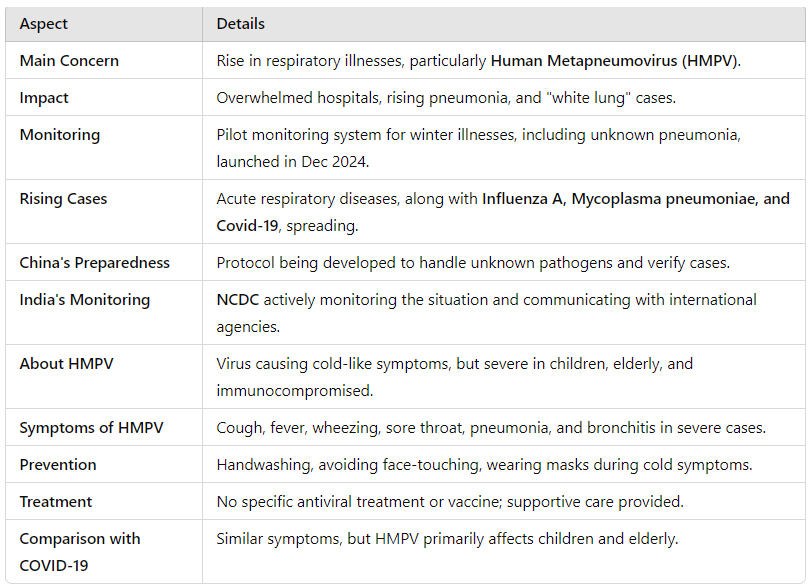
|
|
|
|
Frequently Asked Questions (FAQs) in Competitive Exams:
Q1. Which virus is primarily contributing to the recent surge in respiratory diseases in China? (a) Influenza A (b) Human Metapneumovirus (HMPV) (c) Mycoplasma pneumoniae (d) COVID-19 Answer: (b) Human Metapneumovirus (HMPV) Q2. Which of the following age groups is most affected by HMPV? (a) Young adults (b) Middle-aged individuals (c) Children and the elderly (d) All age groups equally Answer: (c) Children and the elderly Q3. Which Indian agency is closely monitoring the rise in respiratory diseases in China? (a) Indian Council of Medical Research (ICMR) (b) National Centre for Disease Control (NCDC) (c) All India Institute of Medical Sciences (AIIMS) (d) Ministry of External Affairs Answer: (b) National Centre for Disease Control (NCDC) Q4. What are the similarities between HMPV and COVID-19? (a) Both cause respiratory issues like cough, fever, and shortness of breath. (b) Both primarily affect children and elderly. (c) Both have specific antiviral treatments available. (d) Both are caused by the Pneumoviridae family of viruses. Answer: (a) Both cause respiratory issues like cough, fever, and shortness of breath. |
| History |
|
|
|
No common place for Memorial is designated for Prime ministers as different PMs have different places for memorial. Eg. When Nehru died, in May 1964, a space adjoining Raj Ghat was earmarked for his last rites and his memorial named Shanti Van whereas the memorial of Morarji Desai, called Narayan Ghat is at Ahmedabad. Also, V P Singh does not even have an official memorial.
Delhi Memorials (most are in Delhi): Mahatma Gandhi → Raj Ghat: "Gandhi was the Father of the Nation, the King (Raj) of simplicity." Jawaharlal Nehru → Shanti Van: "Nehru dreamed of peaceful (Shanti) gardens (Van)." Lal Bahadur Shastri → Vijay Ghat: "Shastri's victory (Vijay) in war is remembered." Indira Gandhi → Shakti Sthal: "Indira's strength (Shakti) as a leader." Rajiv Gandhi → Vir Bhumi: "Rajiv, the brave (Vir) leader, rests here." Charan Singh → Kisan Ghat: "Charan Singh, champion of farmers (Kisans)." Chandra Shekhar → Jannayak Sthal: "Chandra Shekhar, the leader (Nayak) of people (Jan)." Atal Bihari Vajpayee → Sadaiva Atal: "Atal, forever steadfast (Sadaiva)." V. Narasimha Rao → Gyan Bhumi: "Narasimha, the scholar (Gyan)." Ahmedabad Memorials: Gulzarilal Nanda → Abhay Ghat: "Gulzarilal, a fearless (Abhay) leader." Morarji Desai → Narayan Ghat: "Morarji, inspired by Narayan ideals." Other Delhi Memorials (combine in pairs for simplicity): Giani Zail Singh → Ekta Sthal: "Unity (Ekta) symbolized by Zail Singh." Shankar Dayal Sharma → Karma Bhumi: "Sharma's dedication (Karma)." Jagjivan Ram → Samata Sthal: "Equality (Samata) championed by Jagjivan Ram." Devi Lal → Sangharsh Sthal: "Devi Lal’s struggle (Sangharsh) for farmers." K. R. Narayanan → Uday Bhumi: "Narayanan, a rising (Uday) leader." India’s first President Rajendra Prasad has a memorial in Patna (he belonged to Bihar) called Mahaprayan Ghat. Dr B R Ambedkar’s memorial called Chaitya Bhoomi is located next to Dadar Chowpatty in Mumbai. |
|
|

|
|
|
|
Trick To Remember:
Imagine a procession in Delhi: Gandhi (Raj) leads, followed by Nehru (Shanti), Shastri (Victory), Indira (Strength), and Rajiv (Bravery). Charan (Farmer) and Chandra (Leader) join. At the end, Atal (Forever) and Rao (Knowledge) close the march. Then think of Ahmedabad: Nanda (Fearless) stands tall, and Morarji (Narayan) reflects devotion. |
| Sports |
|
|
|
Ministry of Youth Affairs & Sports announced the National Sports Awards 2024 on 2nd December 2024. Manu Bhaker, D Gukesh, Harmanpreet Singh and Praveen Kumar have been honoured with the Major Dhyan Chand Khel Ratna Award.
The 22-year-old Bhaker became independent India’s first athlete to win two medals in a single edition of the Olympics with her bronze-winning show in the 10m air pistol individual and 10m air pistol mixed team events in August. In the same Games, Hamranpreet led the Indian hockey team to its second consecutive bronze medal. The 18-year-old Gukesh, on the other hand, became the youngest ever World champion while also helping the Indian team win a historic gold in the Chess Olympiad last year. The fourth recipient will be para high-jumper Praveen, who was crowned the T64 champion in the Paris Paralympics. The T64 classification is for athletes who have one or both legs missing below the knee and rely on a prosthetic leg for running. The awardees will receive their awards from the President of India at a specially organized function at Rashtrapati Bhavan on 17th January 2025 (Friday) at 11AM. Based on the recommendations of the Committee and after due scrutiny, Government has decided to confer awards upon the following sportspersons, coaches, university and entity:  Sports ministry names 32 athletes, including 17 para-athletes, for Arjuna awards. The list includes Jyothi Yarraji, Annu Rani, Nitu, Saweety, Vantika Agrawal, Salima Tete, Abhishek, Sanjay, Jarmanpreet Singh, Sukhjeet Singh, Rakesh Kumar, Preeti Pal, Jeevanji Deepthi, Ajeet Singh, Sachin Sarjerao Khilari, Dharambir, Pranav Soorma, H Hokato Sema, Simran, Navdeep, Nitesh Kumar, Thulasimathi Murugesan, Nithya Sre Sumathy Sivan, Manisha Ramadass, Kapil Parmar, Mona Agarwal, Rubina Francis, Swapnil Suresh Kusale, Sarabjot Singh, Abhay Singh, Sajan Prakash and Aman. 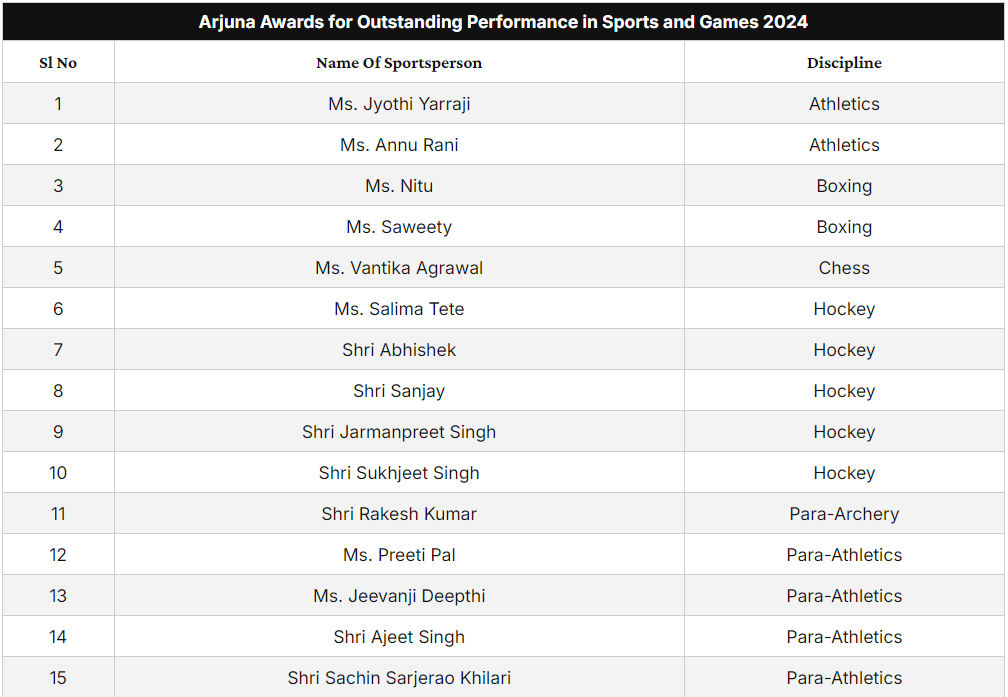 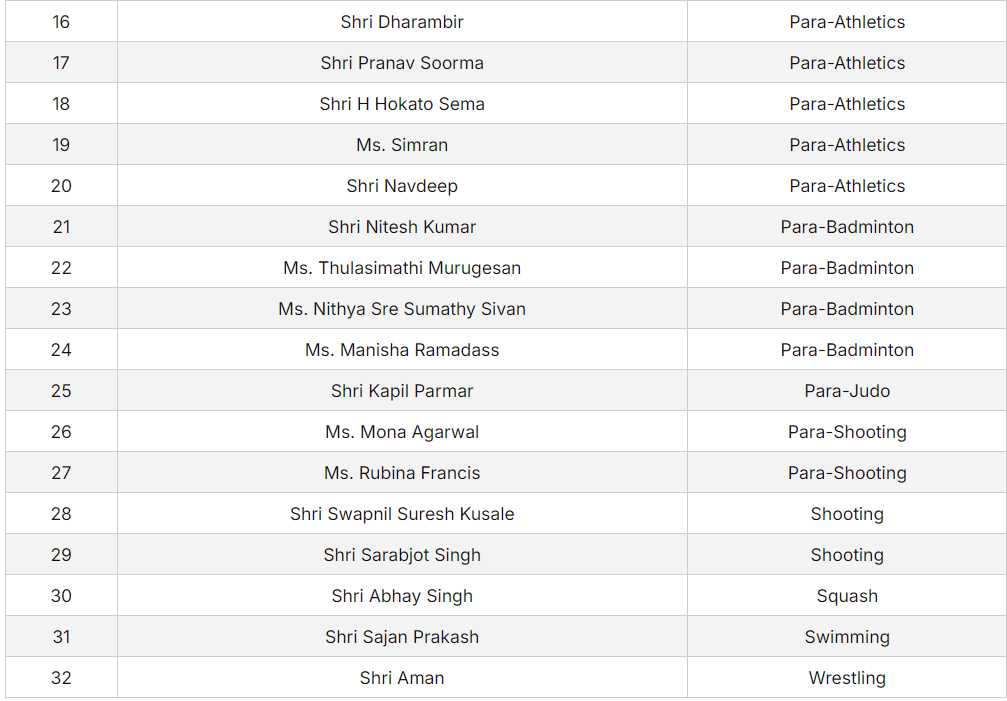 Former cyclist Sucha Singh and former para-swimmer Murlikant Rajaram Petkar were awarded Arjuna Awards (Lifetime) for outstanding performance in Sports and Games.  Subhash Rana (para-shooter), Deepali Deshpande (shooting) and Sandeep Sangwan (hockey) were named Dronacharya Award 2024 recipients. S Muralidharan (badminton) and Armando Agnelo Colaco (football) were awarded the Dronacharya Award in the lifetime category.  Physical Education Foundation of India was given the Rashtriya Khel Protsahan Puraskar while Chandigarh University (overall winner), Lovely Professional University (first runner-up) and Guru Nanak Dev University, Amritsar (second runner-up) were awarded Maulana Abul Kalam Azad (MAKA) Trophy 2024.  The overall top-performing university in Khelo India University Games is given the Maulana Abul Kalam Azad (MAKA) Trophy. |
| Appointments and Resigns |
|
|
|
Event: Rajendra Vishwanath Arlekar was sworn in as the 23rd Governor of Kerala on Thursday.
Venue: The oath-taking ceremony was held at Raj Bhavan, Kerala. Successor: Arlekar succeeded Arif Mohammed Khan, who has been appointed as the Governor of Bihar. Attendees: Kerala Chief Minister Pinarayi Vijayan Cabinet Ministers Senior leaders of various political parties Arrival in Kerala: Arlekar arrived in Kerala’s capital on Wednesday and was welcomed at the international airport by: Chief Minister Pinarayi Vijayan Kerala Assembly Speaker A N Shamseer Ministers K Rajan and Ramachandran Kadannappally Presidential Appointment: Last week, the President of India, Droupadi Murmu, appointed Arif Mohammed Khan as the Governor of Bihar. Rajendra Vishwanath Arlekar was appointed as the Governor of Kerala. |
|
|
|
About Governor Appointment in India
Constitutional Provision: The appointment of Governors is governed by Article 155 and Article 156 of the Indian Constitution. The Governor is the constitutional head of a state. Appointing Authority: The President of India appoints the Governor of a state. The appointment is made on the advice of the Council of Ministers headed by the Prime Minister. Eligibility Criteria: The individual must be a citizen of India. Must have completed 35 years of age. Cannot hold any office of profit during their tenure. Term of Office: The Governor holds office for a term of 5 years but serves at the pleasure of the President. This means the term can be shorter if the President decides to remove the Governor. Dual Role: The Governor acts as the constitutional head of the state. They act as a link between the Union and the State Government. Powers and Responsibilities: Executive Powers: Appoints the Chief Minister and other ministers, advocates general, and State Election Commissioners. Legislative Powers: Summons and dissolves the state legislature, gives assent to bills, and recommends President's Rule. Judicial Powers: Grants pardons, reprieves, or remissions in certain cases. Transfer and Appointment: A Governor may be transferred from one state to another during their tenure. Sometimes, one person is appointed as the Governor for multiple states simultaneously. Recent Trends: Appointments are often influenced by political considerations. Retired civil servants, judges, or politicians are frequently chosen as Governors. Role During Emergency: In case of a constitutional crisis, the Governor can recommend President’s Rule in the state under Article 356. Significance: The Governor ensures that the state government acts according to the provisions of the Constitution. They play a crucial role during transitions of power and crises in the state. |
|
<< 2-Jan-25
|
|
|
